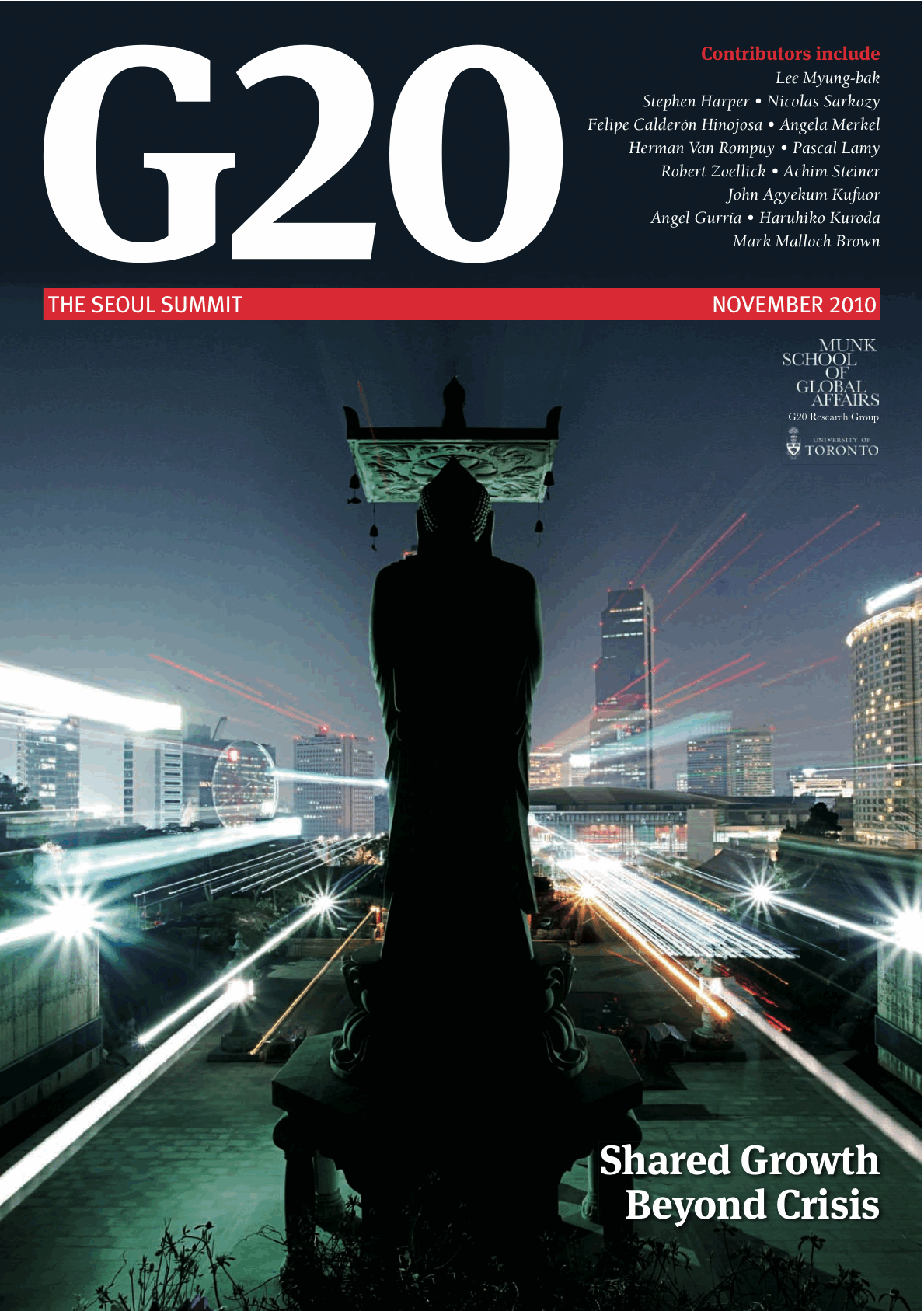

 |
 |
|

By Nobuo Tanaka, executive director, International Energy Agency
Developing a low-carbon global energy system would pose challenges, but would enhance security, mitigate climate change and encourage green growth. With strong political and financial commitment, the G20 can lead the way
To download a low-resolution pdf, click here. (Be patient! It's 50 MB.)
Without major changes to the way the world produces and uses energy, it will confront untenable risks to its collective energy security and to the environment. The International Energy Agency (IEA) considers that the development and deployment of low-carbon energy technology makes sense not only to enable governments to achieve reductions in carbon dioxide emissions, but also to ensure energy security by introducing new sources of energy and contributing to green growth. G20 countries account for more than 80 per cent of global energy consumption and a large portion of carbon dioxide emissions. They must lead the way to a clean energy future.
The IEA recently released the 2010 edition of Energy Technology Perspectives (ETP), a comprehensive study that identifies different mixes of technologies that enable governments to achieve their energy policy goals by 2050. ETP demonstrates clearly that decisive action is necessary if the world is to avoid an insecure, dirty and expensive energy future. Given the current trajectory, in the ETP business-as-usual (or baseline) scenario, where no new policies are implemented, total primary energy supply would increase above 80 per cent between 2007 and 2050. Energy-related carbon dioxide emissions would double by 2050. Rising oil and gas imports and high prices also feature. Most of the growth in energy use will occur in countries that are not members of the Organisation for Economic Co-operation and Development (OECD) and where fossil fuel demand increases very rapidly. This highlights the need for a collective global effort to address energy and climate change challenges.
The goal of ETP is to show which technology policies and options will halve global carbon dioxide emissions (from 2005 levels) by 2050. The ‘BLUE Map Scenario’ (consistent with limiting the rise in global temperatures to 2°C to 3°C in the long term) sets out the opportunity for a very different future. In this scenario, primary energy demand for fossil fuels is 26 per cent lower in 2050. Fossil fuel dependency should drop from 81 per cent today to 46 per cent in 2050. Demand for coal, oil and gas in 2050 is lower than today. Global oil consumption is reduced by 27 per cent compared to current levels. Demand should peak earlier than supply. Not only would this alternate future cut emissions, but it would also reduce demand and diversify energy sources, thus improving energy security.
Achieving the BLUE Map scenario is possible. But it is an extremely challenging goal that requires a portfolio of technologies and emissions reductions across all sectors, as well as strong political commitment. To achieve it by 2050, additional investments (relative to the baseline scenario) of $46 trillion are needed between 2010 and 2050. These additional costs will be more than offset by fuel cost savings: undiscounted savings are estimated at $112 trillion, but a carbon price of $175 per tonne of carbon dioxide in 2050 is needed. In addition, this is a huge business opportunity that offers significant potential for fostering green growth.
So how can governments move forward? IEA work has shown that the first essential step is improving energy efficiency. Often called the ‘quiet giant’, end-use efficiency accounts for 38 per cent of total emissions reduction in 2050. Decarbonising the power sector will be critical to achieving deep emissions reductions. This requires aggressive investments in nuclear, carbon capture and storage (CCS) and renewables. Ways to transform global energy markets must be found so that clean energy becomes the rule, not the exception. Moreover, efforts must be made to decarbonise the transportation sector. Improved vehicle efficiency and the mass introduction of electric vehicles are required, among a host of other actions.
Another important policy action for major economies is to phase out fossil fuel subsidies, which impede the uptake of energy efficiency and cleaner energy technologies. Such subsidies reduce incentives, distort market signals and create dependence on fossil fuels. For the G20 Toronto Summit in June 2010, the IEA, along with the Organization of Petroleum Exporting Countries (OPEC), the OECD and the World Bank, prepared a report that highlighted the benefits for eliminating fossil fuel subsidies by 2020. Energy demand would decline by 5.8 per cent and annual oil savings would reach 6.5 million barrels per day, leading to an annual 2.4 Gt reduction in energy-related carbon dioxide emissions. Many countries, notably China, India, Russia and Indonesia, are already taking measures to reduce or eliminate fossil fuel subsidies. The IEA applauds these efforts and supports the G20’s commitment to eliminate inefficient fossil fuel subsidies by further monitoring the progress.
Support for research, development and demonstration (R&D) will also be crucial. The level of annual spending will need to be raised two to five times pre-stimulus (2008) levels, up to $50 billion a year. In 2009, governments around the world allocated more than $520 billion to clean energy technologies — from energy efficiency in buildings to high-speed railways to support for renewable energy technologies. Of this amount, about $22 billion was directed to RD&D. While this is a promising step, it is still not enough. Governments face many funding priorities — but the goal must reach beyond the short term in order to achieve long-term results. At a minimum, the levels achieved with stimulus spending in 2009 must be sustained. In the aftermath of the global economic crisis, it will be a challenge to find ways to continue such spending.
One important way to support R&D is to enlist the private sector. Private sector spending on technology innovation is currently low. Compared to other sectors, the energy sector spends the smallest portion of its sales on research and development — less than one half of 1 per cent (compared to 19 per cent for health care, 12 per cent for defence, 8 per cent for information technology and 2 per cent for the automotive sector). Governments must increase incentives to raise industry RD&D spending, for example, by setting long-term, predictable policies that create stable technology markets.
There are some promising national policies aimed at addressing gaps in technology development. India recently approved a levy on coal production that will result in nearly $500 million per year for new clean energy R&D. Korea’s “green new deal” strategy is leading the way. The United States and the United Kingdom have also addressed key areas where technology development has often stopped — the valleys of death at pre-commercial development and in large-scale demonstration. They have done this through the creation of targeted new institutions such as the Advanced Research Projects Agency-Energy (ARPA-E) and the Green Investment Bank.
In addition, broader, more coordinated international cooperation is essential. Several G20 countries recently participated in the launch of the International Low-Carbon Energy Technology Platform. This initiative — originated in 2008 by the IEA at the request of the G8 — addresses the need for enhanced international collaboration on low-carbon energy technology development. This shared agenda among developed, emerging and developing countries provides a promising avenue for pursuing national and international climate change and energy security objectives. The platform could be a vehicle for maintaining momentum and coordination between G20 meetings and for reaching out to countries not represented there.
Moving to a low-carbon global energy system would enhance security, mitigate climate change and spawn green growth. The transformation will be challenging but is attainable. The G20 can lead the way to a cleaner energy future, but must start now. Strong and unwavering political and financial commitment are essential.
|
This Information System is provided by the University of Toronto Library |
All contents copyright © 2024. University of Toronto unless otherwise stated. All rights reserved.